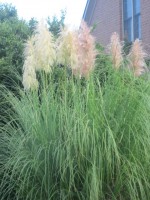 Ornamental grasses are versitile and can soften the look of a garden as well as give a naturalistic feel. They are valued for their different textures and colors and the way they add catch light and bring movement to the garden. Grasses are generally easy to grow, require little maintenance and can be useful as an architectural accent, backdrop, edger, hedge, screen, windbreak, erosion control, groundcover, and for a container or rock garden. Many grasses need a considerable amount of water but some are drought tolerant and do well with occassional waterings when rainfall is limited. Here are 6 ornamental grasses that are considered drought tolerant. They are all beautiful additions to the garden especially to a xeriscape and can be combined with annuals, perennials, shrubs, and trees to provide year round interest.Blue Gama (Bouteloua gracilis)
Ornamental grasses are versitile and can soften the look of a garden as well as give a naturalistic feel. They are valued for their different textures and colors and the way they add catch light and bring movement to the garden. Grasses are generally easy to grow, require little maintenance and can be useful as an architectural accent, backdrop, edger, hedge, screen, windbreak, erosion control, groundcover, and for a container or rock garden. Many grasses need a considerable amount of water but some are drought tolerant and do well with occassional waterings when rainfall is limited. Here are 6 ornamental grasses that are considered drought tolerant. They are all beautiful additions to the garden especially to a xeriscape and can be combined with annuals, perennials, shrubs, and trees to provide year round interest.Blue Gama (Bouteloua gracilis)
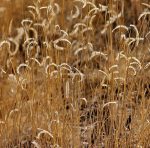
Also called mosquito grass, this warm-season tufted perennial is native to southern and western US where it was the dominant grass in the short grass prairie and grows in the plains as well as open rocky woodlands and abandoned sites. The narrow, green to bluish gray leaves form dense clumbs 12-15″ tall that turn golden brown in the fall sometimes with red or orange tints. The purplish-red flowers appear in 2″ long, comb-like spikes above the foliage on arching stems 24″ long from early to late summer. The spikes form horizontally on one side of the stem and resemble a swarm of mosquitos or other insect. Plants are very drought tolerant and can be used in beds, borders, meadow, prairie, rock, container, wildflower or native plant gardens and are especially valuable in xeriscapes. The flowers are attractive in dried arrangements.
Type: Warm season perennial grass
Height: 8-24″
Light:Full sun; tolerates some shade
Hardiness: Zones 3-10
Photo Credit: Patrick Alexander Wikimedia Commons
Pampas Grass (Cortaderia selloana)
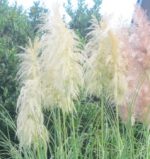 Native to Brazil, Argentina and Chile, this perennial grass forms large clumps of arching, narrow silvery-gray/blue-green leaves with finely toothed margins. In August large blond to pink plumes appear above the the foliage and persist into winter when most other plants are dormant. They look especially well placed against a dark background or where they can be back lit. Used as a specimen plants, hedge, or back of the border planting, pampas grass provided an architectural statement. Since the plants have razor sharp leaves, however, they should not be located on a walk or near a place where people are likely to brush up against them. They are vigorous plants and can become invasive so have been banned in some countries. Plumes are attractive in both fresh and dried arrangements.
Native to Brazil, Argentina and Chile, this perennial grass forms large clumps of arching, narrow silvery-gray/blue-green leaves with finely toothed margins. In August large blond to pink plumes appear above the the foliage and persist into winter when most other plants are dormant. They look especially well placed against a dark background or where they can be back lit. Used as a specimen plants, hedge, or back of the border planting, pampas grass provided an architectural statement. Since the plants have razor sharp leaves, however, they should not be located on a walk or near a place where people are likely to brush up against them. They are vigorous plants and can become invasive so have been banned in some countries. Plumes are attractive in both fresh and dried arrangements.
Type: Perennial grass
Height: 12′
Light: Full sun
Hardiness: Zones 7-10
Sand Lovegrass (Eragrostis trichodes)
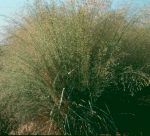 Native to prairies, open woods, rocky slopes and roadsides of the western plains states, this perennial grass has erect to arching leaves that are 6-36″ long. The flowers and seedheads are carried in airy panicles on 4′ long stems and are narrow a first but spread to 12″ wide. The flowers are bright green tinted with red from midsummer to early autumn and then turn buff-brown. Plants are drought tolerant and a good choice for beds, borders, cottage, native plant, prairie, and wildflower gardens.
Native to prairies, open woods, rocky slopes and roadsides of the western plains states, this perennial grass has erect to arching leaves that are 6-36″ long. The flowers and seedheads are carried in airy panicles on 4′ long stems and are narrow a first but spread to 12″ wide. The flowers are bright green tinted with red from midsummer to early autumn and then turn buff-brown. Plants are drought tolerant and a good choice for beds, borders, cottage, native plant, prairie, and wildflower gardens.
Type: Perennial grass
Height: 6-36″
Light: Full sun
Hardiness: Zones 5-9
Photo Credit: Wikipedia
Blue Fescue (Festuca glauca aka F. ovina aka F. cinerea)
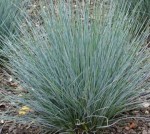 Also known as sheep’s fescue, this cool season perennial grass was native to Europe but has been bred for color, texture, flowering habit, and size and now is represented by over 25 cultivars. Plants form dense, fine textured, evergreen or semievergreen clumps 6-12″ tall and can be bright blue to dark green depending on the cultivar. Terminal panicles of flowers appear well above the foliage in late spring to early summer and may be showy or inconspicuous. Atleast one cultivar, however, lacks flowers. When present, the flowers are light green tinged with purple at first but turn buff colored as they mature and are considered unattractive by some gardeners. The plants are drought and pollution tolerant and are very attractive as groundcovers and edgers, and in containers and rock gardens. The plants are short-lived and the foliage may die out in the center in hot humid climates. The most popular and widely available cultivar is ‘Elijah Blue’ (soft powdery blue, medium texture, 8″)
Also known as sheep’s fescue, this cool season perennial grass was native to Europe but has been bred for color, texture, flowering habit, and size and now is represented by over 25 cultivars. Plants form dense, fine textured, evergreen or semievergreen clumps 6-12″ tall and can be bright blue to dark green depending on the cultivar. Terminal panicles of flowers appear well above the foliage in late spring to early summer and may be showy or inconspicuous. Atleast one cultivar, however, lacks flowers. When present, the flowers are light green tinged with purple at first but turn buff colored as they mature and are considered unattractive by some gardeners. The plants are drought and pollution tolerant and are very attractive as groundcovers and edgers, and in containers and rock gardens. The plants are short-lived and the foliage may die out in the center in hot humid climates. The most popular and widely available cultivar is ‘Elijah Blue’ (soft powdery blue, medium texture, 8″)
Type: Cool season perennial grass
Height: 6-12″
Light: Full sun
Hardiness: Zones 4-9
Blue Oat Grass (Helictotrichon sempervirens)
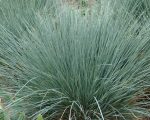 Blue oat grass is a clumping, cool season, evergreen to semievergreen ornamental grass, native to Eurasia where it grows in meadows and on dry hillsides. Plants form a dense tuft 12-18″ tall of arching, metallic blue leaves with sharply pointed tips. In early to mid summer, spikelets of oat-like flowers appear in open panicles on arching stems 1-2″ above the foliage. The flowers are bluish white at first and dry to a golden wheat color. Plants resemble blue fescue (Festuca glauca) but are larger. Blue oat grass is valued primarily for its blue foliage and is attractive in borders or as a groundcover, as well as in Meditrranean, rock and coastal gardens.
Blue oat grass is a clumping, cool season, evergreen to semievergreen ornamental grass, native to Eurasia where it grows in meadows and on dry hillsides. Plants form a dense tuft 12-18″ tall of arching, metallic blue leaves with sharply pointed tips. In early to mid summer, spikelets of oat-like flowers appear in open panicles on arching stems 1-2″ above the foliage. The flowers are bluish white at first and dry to a golden wheat color. Plants resemble blue fescue (Festuca glauca) but are larger. Blue oat grass is valued primarily for its blue foliage and is attractive in borders or as a groundcover, as well as in Meditrranean, rock and coastal gardens.
Type: Cool season, evergreen to semievergreen, perennial grass
Height: 2-3′
Light: Full sun
Hardiness: Zones 4-9
Photo Credit: Wikimedia Commons
Pine Muhly Grass (Muhlenbergia dubia)
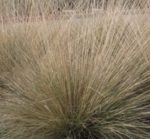 This evergreen, clump-forming, perennial grass is native to higher elevations of eastern Arizona, New Mexico, west Texas, and northern Mexico. Plants form dense fine-textured mounds of narrow leaves 1-3′ tall. In late summer and fall 3-4′ long erect spikes carry cream colored flowers that turn tan as they mature. Pine muhly grass resembles California deergrass (M. rigens) but is only about half the size so is suitable for smaller gardens. Since pine muhly grass is heat and drought resistant it is a good choice for xeriscapes and can be used as a hedge, accent plant, or groundcover, and in containers.
This evergreen, clump-forming, perennial grass is native to higher elevations of eastern Arizona, New Mexico, west Texas, and northern Mexico. Plants form dense fine-textured mounds of narrow leaves 1-3′ tall. In late summer and fall 3-4′ long erect spikes carry cream colored flowers that turn tan as they mature. Pine muhly grass resembles California deergrass (M. rigens) but is only about half the size so is suitable for smaller gardens. Since pine muhly grass is heat and drought resistant it is a good choice for xeriscapes and can be used as a hedge, accent plant, or groundcover, and in containers.
Type: Evergreen perennial grass
Height:1-3′
Light: Full sun
Hardiness: Zones 7-10